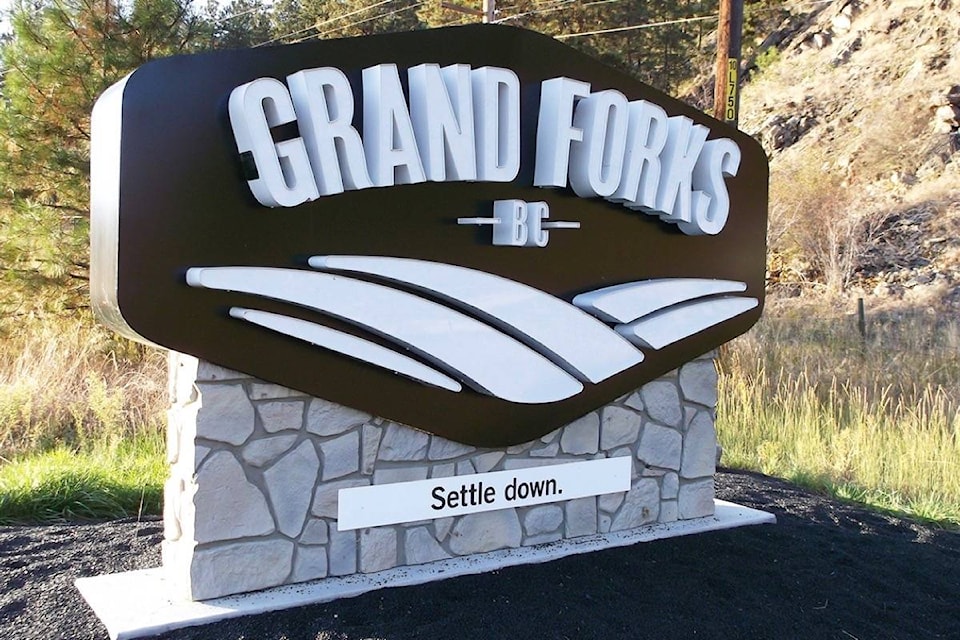A series on West Kootenay/Boundary place names
We’ve spent the last few weeks looking at civic nicknames and slogans. Here are some more.
• In March 1921, T.A. Love won $10 in a Grand Forks Board of Trade slogan contest with his suggestion to brand the city the Sunshine Valley. The Grand Forks Sun, despite its own name, abhorred this choice, finding it unoriginal. The newspaper quoted one anonymous letter-writer: “I wish to protest emphatically against the use of the proposed slogan, ‘Grand Forks, the Sunshine Valley,’ for several reasons, chief of which is that it is too much like ‘Sunny Alberta,’ where the crops dry up and blow away.”
The Sun’s protests were for naught; the name became entrenched.
Grand Forks later adopted one of the most unique slogans in the region: “Famous for sunshine and borscht.” It was in use by 1989. A rebranding effort a few years ago resulted in some new slogans: “Settle down” and “Original peaceful living.”
• Beginning in 1898, Greenwood and Grand Forks both claimed to be the Metropolis of the Boundary, although Greenwood used it more often.
• Greenwood is now Canada’s Smallest City (by population), a claim it has been able to make since 1959, when Kaslo re-incorporated as a village, but it doesn’t show up in print until 1968 — and then only infrequently until the 1980s.
• Cascade was known as the Gateway City (Cascade Record, Nov. 12, 1898 and each issue thereafter). Christina Lake, despite being in the Boundary, was the Killarney of the Kootenay (Grand Forks Gazette, May 27, 1909) or BC’s Hidden Jewel (The Vancouver Sun, July 28, 1978) or Canada’s Warmest Tree-Lined Lake (Calgary Herald, March 30, 1988).
• Phoenix, the Boundary ghost town, was the Highest City in Canada, given its elevation of 1,412 m. The name first showed up in The Ledge of Oct. 5, 1911: “The Phoenix Brewery Co. shows in bottles and kegs a temping display of the wet goods that have made the highest city in Canada famous.”
• Nakusp was once the Zenith City (Revelstoke Kootenay Star, June 25, 1892); now it’s the Hidden Gem of the Kootenays, which first shows up in a classified ad in The Vancouver Sun of July 24, 1987. However, the Cranbrook Golf Club also claims to be the Hidden Gem of the Kootenays.
• The Slocan Valley ghost town of Three Forks was delightfully nicknamed the Pronged City (Nakusp Ledge, Nov. 15, 1894 and thereafter) and also the Sunless City (The Ledge, Feb. 7, 1895). Only a few weeks later, however, the latter nickname was applied to Sandon (The Ledge, Feb. 28 1895).
It was an apt description. Onetime Sandon resident Edith Greer told an interviewer in 1972: “In January, we would meet our neighbors and say ‘How long did you have the sun today? I had it for two minutes.’ We learned to appreciate the sun. Most people take it for granted. It would come over the mountains and we would think spring was really on the way when we had it for two minutes.”
We’ve previously seen how Sandon was the original Silver City, a name later applied to Trail.
It was also sometimes compared to Monte Carlo, due to the gambling that went on there. The Ledge of April 12, 1900, in referring to Sandon, said “A calamity of this kind would be disastrous to the Monte Carlo of the Slocan.” The Paystreak added on Jan. 26, 1901: “Sandon is the only town this side of Monte Carlo that knows no limit.”
And in his Float magazine of 1903-04, Robert T. Lowery wrote of Sandon: “The camp never closed up. It was one long carnival of cards, wine, and women. When one shift went fluey another took its place, and Canada’s Monte Carlo never blinked an eye.”
Earlier, Lowery speculated that Kaslo “might blossom into a second Monte Carlo,” if the city relaxed its regulations on gambling (The Ledge, July 4, 1895). It already had “more salons than any other town of its size in Canada,” and supported the Comique, a sort of burlesque theatre.
Next week we’ll look at Kaslo’s many nicknames.
DEMONYMS, REVISITED
Regarding our recent look at what you call people from different places, Jonathan Kalmakoff of the Doukhobor Genealogy Website writes:
“While I’ve never heard of an Ootischenian, I have heard the term Uteshensky (Утешенский) which would be the Russian form of denonym used by the Doukhobors themselves to describe someone from Utesheniye/Ootischenia. The -sky ending is an adjectival form in Russian generally meaning ‘from, belonging to, or associated with’ and similar forms would be used to generically describe Doukhobors from other settlements — hence Blagodatinsky for people from Blagodatnoye, Krestovsky for people from Krestova; and so on.
“While you’d be hard pressed to find a published example of the Russian -sky denonyms, nor much knowledge of them around English-speaking locals, they received widespread usages among the hundreds of Russian-speaking Doukhobors of the area, traditionally.”
